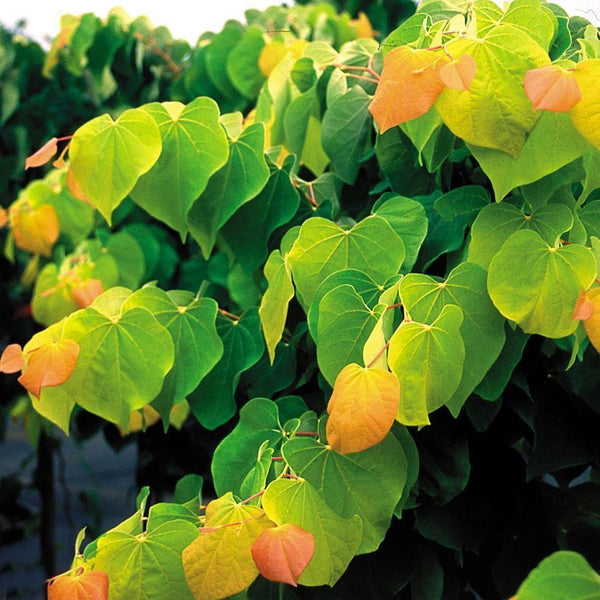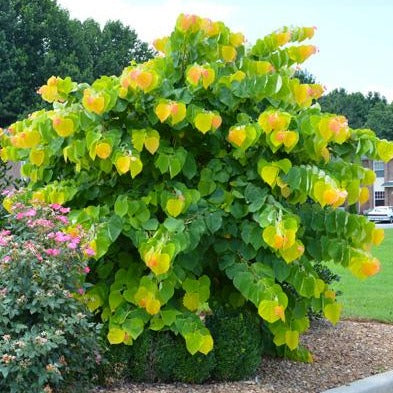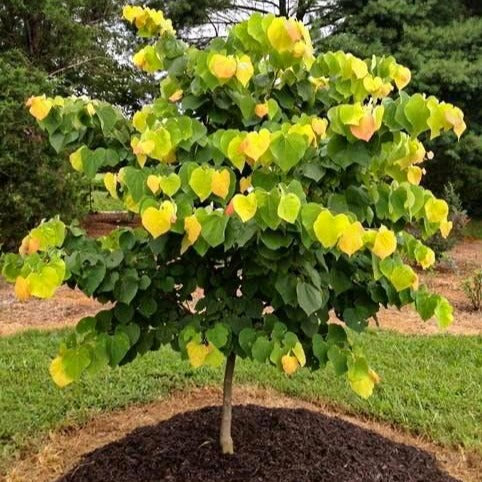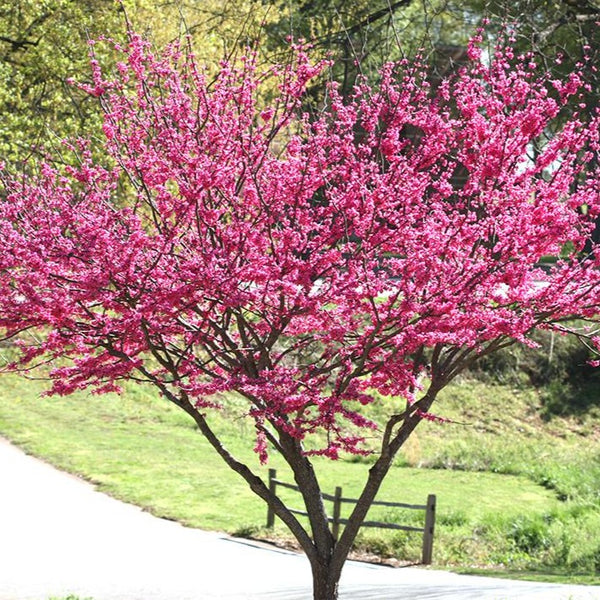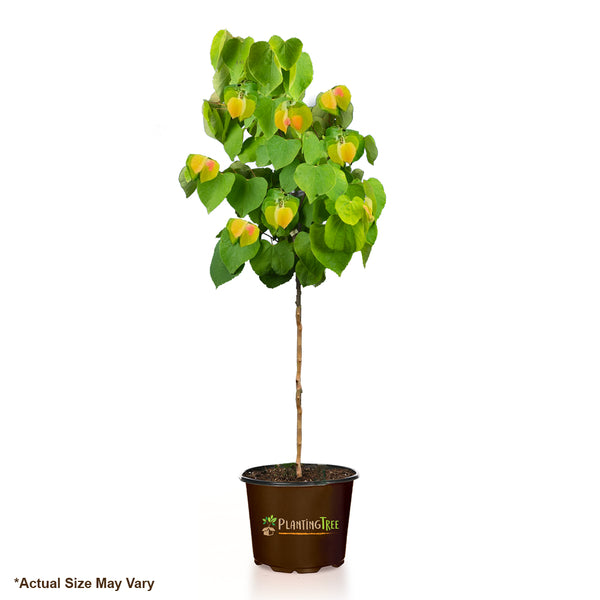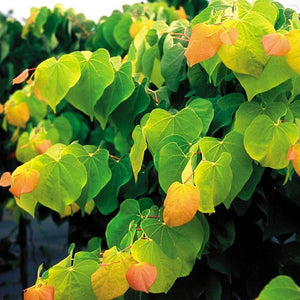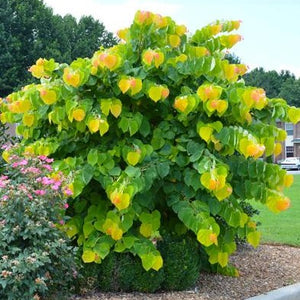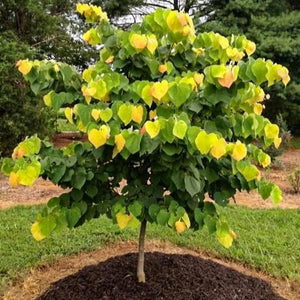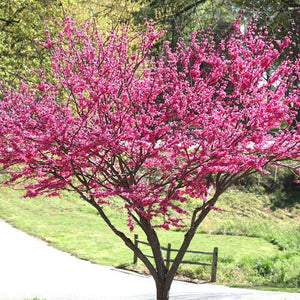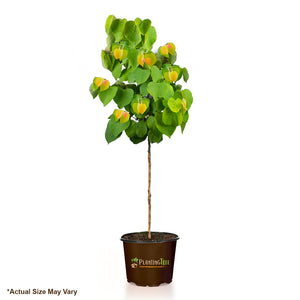Rising Sun Redbud
Product Details
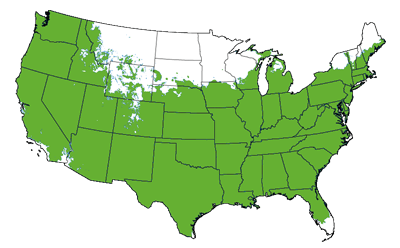 Growing Zones 5-9
Growing Zones 5-9
| Soil Type | Adaptable |
| Sunlight | Full, Partial |
| Drought Tolerance | Good |
| Mature Height | 6-10 Feet |
| Mature Width | 6-10 Feet |
| Growth Rate | moderate |
| Fall Color | Yellow |
| Bloom Color | Pink |
| Shipping Restriction | AZ, OR |
This is one of our Favorites! This Rising Sun Redbud tree has what others don't. Watch as its heart-shaped leaves transform into a work of art. Each leaf has a tri-color to it. Enjoy yellow, orange, and apricot colors during the summer and fading into a lime green when it gets hot. Wait... we forgot about spring. As spring approaches, beautiful fuchsia pink blooms cover its branches that really brighten your day.
The Rising Sun Redbud needs to be planted in an area where it will receive full sun. It reaches heights of up to 8-12 feet tall and about 8 feet wide. It will need regular watering once it gets hot but other than that, it's quite the tree.
Birds and Butterflies will also be attracted to your Rising Sun Redbud tree.
This is the ideal tree for a specimen or focal point in your landscape.
Where Should This Tree Be Planted?
This redbud is adaptable to a variety of soils and thrives in full sun to part shade exposure in grow zones 5-9. They can be used as a focal point in the yard and they look even better with uplighting.
When Does A Rising Sun Redbud Bloom?
Expect beautiful blooms from this tree and multicolored foliage from spring to the fall seaon.
How Do I Shape This Redbud?
These trees dont generally need to be trimmed back but if desired, prune immediately after blooming has ceased to remove any dead, dying, crowded or crossed branches.
When planting your Rising Sun Redbud be sure you have the right location and conditions for your new tree to thrive. Spring and fall are ideal times to plant. However, if you avoid extreme temperatures you can plant almost any time of the year.
Rising Sun Redbuds are very easy to maintain. These trees tolerate full sun, part sun, and part shade and are adaptable to any soil as long as it isn't saturated. Water your new Redbud deeply about twice a week for the first couple months. After establishment, this redbud is drought tolerant. In extended drought periods this tree will benefit from a weekly deep watering. Add a layer of 2 of mulch around the base of the tree about the size of the tree canopy. Do not allow the mulch to touch the trunk as this increases the chances of pests and disease. Fertilize in early spring and when planting to give your tree a boost. Choose a balanced, slow release fertilizer. Redbuds don't generally require pruning, but if needed, prune immediately after blooming has ceased to remove any dead, dying, crowded or crossed branches. Pruning in winter is likely to cause bloom loss.
The best way to prevent disease and pests is by providing the appropriate care for your plants. Proper location choice, watering and fertilization are the keys to your success. Avoid problems with Borer insects by ensuring your tree remains free from damage, especially from lawn equipment. Mulching helps to keep weeds at bay which eliminates the need to use lawn equipment near your tree. Borers look for a hole or weak spot to penetrate. Scale is an immobile insect that can affect almost any tree. You can treat this pest with horticultural oil. Be sure to coat the entire tree.
Rising Sun Redbud trees can be planted almost anywhere in your yard. They are one of our favorites!
If you have a natural area off to the side of your home, plant a redbud tree here. Enjoy it sparkle with blooms in the spring. Or plant 1 or 2 in your front or back yard. They can be used as a focal point in the yard and they look even better with uplighting.
Rising Sun Redbud trees go very well with most other colors in the landscape. Plant some kaleidoscope abelia under the tree for some beautiful yellow and gold colors. Junipers also work very well. The blues and greens pair well with the fuschia pink blooms!
There really isn't a bad place to plant your new Redbud Tree. Just make sure that you can see it from your window because you will have your eye on it! If you love Redbud trees, you may also be a fan of our Ruby Falls, Forest Pansy, Oklahoma and Royal White Redbud trees.
For additional options, be sure to check out our Redbud Tree and Dwarf Tree collection.



